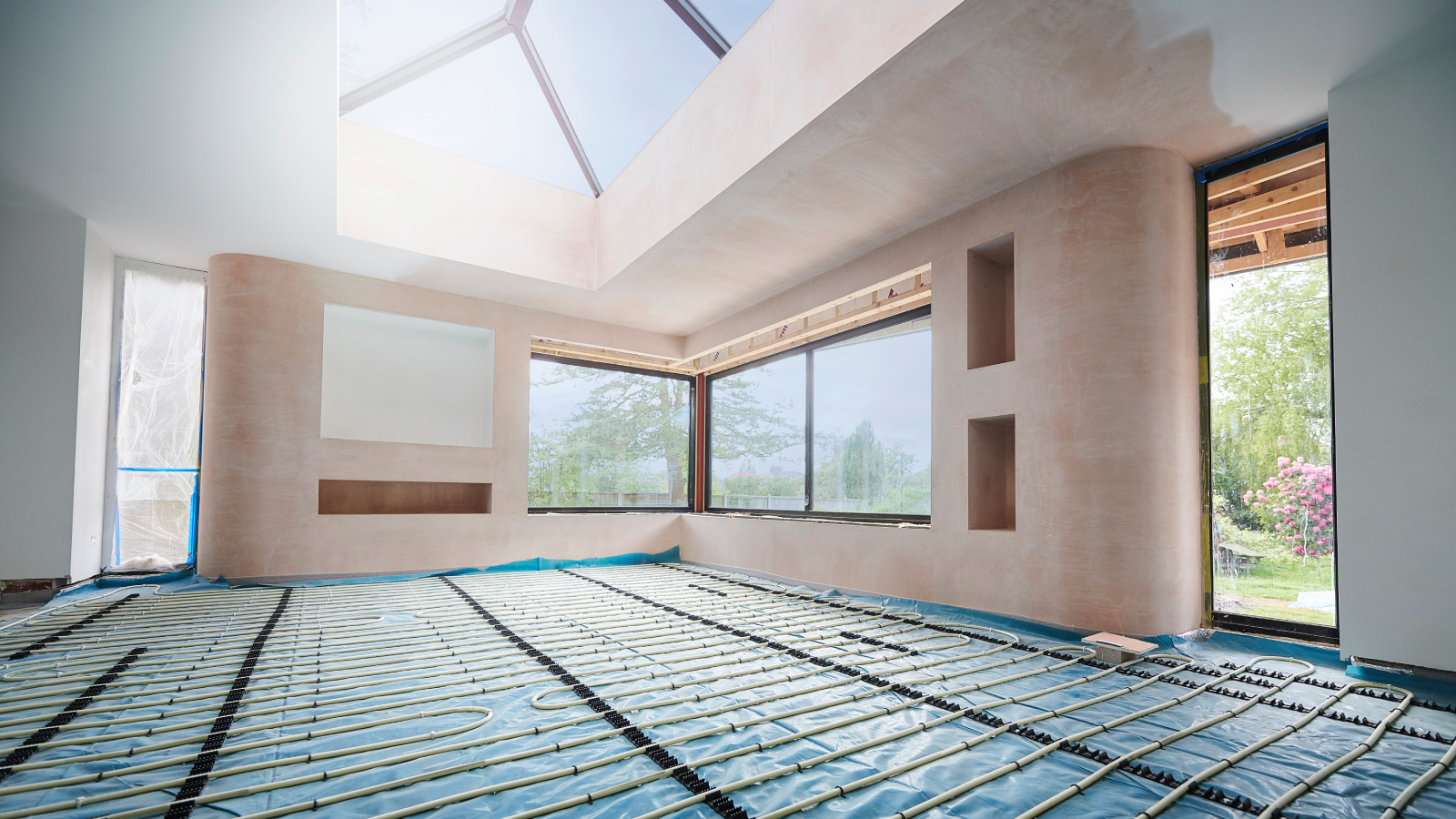Should you install underfloor heating under kitchen cabinets? We asked the experts
The kitchen and construction experts talk through the pros and cons of installing underfloor heating under kitchen cabinets

Underfloor heating can make your kitchen a year-round household hotspot, not only warming your feet pleasantly, but heating the space efficiently too.
You’ll only want to go through the disruption of installing UFH once, especially if you’ve put a lot of care or money into beautiful kitchen flooring, perhaps with tiles or wood. So, it’s important to situate your UFH correctly, and this involves deciding whether the underfloor heating pipes, wiring or mesh will extend under your kitchen cabinets, as well as covering the open floor space.
But, should you install underfloor heating under kitchen cabinets, or should you avoid laying UFH where cabinets will be placed? To find out, we spoke to experts from The Symphony Group, the fitted kitchen specialist, and AS Homes and Construction, a Hertfordshire-based construction company and member of the Federation of Master Builders.
Reasons to lay underfloor heating under kitchen cabinets

Future-proofing your kitchen
The lifespan of kitchen cabinetry tends to fall within a similar range to that of underfloor heating. Both can last anywhere from 20-50 years, depending on their quality, the standard of installation and your usage habits.
However, kitchen cabinets sometimes look dated or ‘tired’ after a decade or two. If you like to keep your home looking as fresh as possible, then you might decide to replace your cabinets before the UFH has had its day. Installing underfloor heating throughout the whole room – including under the kitchen cabinets – will ensure you can redesign the kitchen freely in future.
Ensuring the whole room is heated
Laying underfloor heating right up the wall – including under your cabinets – should reduce the levels of mould, damp and condensation between the wall and cabinets, which is clearly a major plus for health and cleanliness.
This point is most applicable to kitchen units adjoining an external wall. Internal walls (with another room on the other side) are far less susceptible to damp.

Josie Medved is Design Project Manager at The Symphony Group, a leading manufacturer and designer of fitted kitchens. Symphony offers a diverse range of kitchen styles including contemporary, classic, inline and linear, as well as accessible kitchens to support users with disability needs.
Reasons not to lay underfloor heating under kitchen cabinets
Installation and energy costs
The cost of installing underfloor heating is understandably higher when the system needs to cover a larger floor area. As such, laying UFH under your kitchen cabinets will likely increase the cost of installation.
With that said, the cost of laying a few extra square meters of UFH is minimal compared to the overall installation costs. UFH systems tend to cost between around £27 and £95 per square meter, so the additional components required to heat underneath your kitchen cabinets will typically cost under £500 (and perhaps far less than that).
A bigger disincentive is the increased ongoing running cost of powering a larger system. Some UFH systems have higher energy costs than others, but in any case you will pay more to heat a larger area. A power-hungry electric UFH system (like this highly rated BeWarm mat kit at B&Q, £360.35) will cost significantly more to run if it is extended to all parts of the kitchen.
While there may be some upsides to heating under your kitchen cabinets, such as reduced condensation and mould, you might ultimately decide that powering the extra UFH is not worth the ongoing added energy cost.
“In most cases, it’s unnecessary to install underfloor heating beneath fixed kitchen cabinets,” says Medved.
“Not only is it an added expense, but it also provides no tangible benefit since heat can’t easily transfer through the cabinet bases or reach the room effectively.”
Effects on appliances, cabinets and stored items
The effects of underfloor heating upon a kitchen cabinet will vary depending on factors such as the cabinet’s design, its materials, and what’s stored inside. In some cases, such as when a cabinet has feet that give it some ground clearance, then the effects should be minimal.
However, the combination of UFH and floor-level cabinets can sometimes cause issues or inefficiencies.
“Cabinets can act as insulators, preventing heat from circulating properly in the room, which may result in uneven heating,” says Medved.
“Additionally, the heat buildup beneath cabinets could potentially affect the longevity of certain materials, especially if they’re sensitive to temperature changes, such as adhesives or veneers.”
If you do intend to install UFH where kitchen cabinets will be situated, you should perhaps avoid storing perishable foods or heat-sensitive materials in the lower cabinets.

Peter Atkins is Founder and Director of AS Homes & Construction, a family-owned construction business based in Hertfordshire. Atkins is a member of the Federation of Master Builders, the UK’s leading trade association in the construction industry.
Conclusion: how to decide?
Most authoritative sources – including the experts we’ve interviewed – clearly agree that installing UFH under kitchen cabinets is best avoided.
“Underfloor heating is an excellent way of heating a kitchen and the rest of the property, but in our experience, installing it beneath kitchen cabinets is extremely uncommon, and we generally advise against it unless specifically requested by the client,” says Peter Atkins, Founder and Director of AS Homes & Construction.
Medved agrees: “From a design perspective, it’s much more practical to focus the underfloor heating on open areas where it can radiate warmth directly into the room. For example, prioritise areas where people will stand, such as near countertops, islands, or dining spaces.
“If your kitchen includes movable units, it might be worth considering heating underneath, but for fixed cabinetry, it’s generally best avoided,” she says.
So, you should only install UFH under kitchen cabinets in the unlikely event you have an unavoidable reason to do so.

If you’re determined to install underfloor heating where your kitchen cabinets will stand, there are a few precautions you can take to mitigate the possible adverse effects. Atkins reluctantly suggests the use of floating cabinets, made with heat-resistant materials.
“Raised cabinets allow heat to circulate freely, maximising heating efficiency, while heat-resistant materials such as metal, solid wood and engineered wood with proper sealing are better suited for use above underfloor heating,” he says.
“Cabinets with ventilation gaps help dissipate the heat buildup beneath them, and cabinets with insulated bases help protect stored items from prolonged exposure to heat.”
Further to Atkins’ points, it’s worth noting that some kitchen cabinets are fixed into the ground with screws, and this is clearly not a sensible option for fixing into flooring above UFH. If fitting cabinets above underfloor heating, use appropriate wall fixings and/or floor adhesives instead.
But with all that said, it’s probably best to save some money, hassle and risk by limiting your UFH to the open floor space in your kitchen, avoiding the areas under kitchen cabinets altogether.
FAQs
Can you install underfloor heating beneath a fridge-freezer?
It’s not recommended to install underfloor heating beneath a fridge-freezer. The heat from the UFH may adversely affect the fridge-freezer’s performance, and it will not transfer efficiently into the room.
If you already have UFH in your kitchen and you need to move your fridge-freezer, then it’d be best to avoid moving the appliance to a heated area of the floor. However, if there’s no alternative but to place the fridge-freezer in a spot where UFH is already installed, then you can minimise the heat’s effect on the appliance by adding a layer of insulation (e.g. foil) between the two.
Another kitchen component that should not be placed above underfloor heating is a larder, as the heat from the UFH could easily cause stored foods to spoil.
Does it make a difference whether wet UFH or electric UFH is installed under kitchen cabinets?
‘Wet’ UFH is underfloor heating that uses pipework filled with heated water, whereas electric UFH (like these systems from Wickes) uses electrical components to heat the space. Both types of UFH fall foul of some common problems with installation underneath kitchen cabinets, including inefficient heating and potential damage to cabinets and stored items.
Atkins advises against installing UFH under kitchen cabinets, but based on his commentary, wet UFH is arguably more suitable than electric UFH in this particular context.
“Wet systems are reliable as the continuous pipework beneath the surface minimises the risk of leaks, so maintenance is generally limited to the manifold,” he says.
Meanwhile, making repairs to an electric system could necessitate removal of your kitchen cabinets.
“If the electric UFH system fails, repairs are often impractical and involve costly removal of the finished flooring,” says Atkins.
Installing underfloor heating is one of the biggest costs involved in transforming your kitchen, so take your time and plan the project carefully. If you're on a budget, find some inspiration in our roundup of clever kitchen ideas to make your space work harder.
Get the Homebuilding & Renovating Newsletter
Bring your dream home to life with expert advice, how to guides and design inspiration. Sign up for our newsletter and get two free tickets to a Homebuilding & Renovating Show near you.
Pete Wise is a freelance writer and keen DIYer from Leeds. Pete's tool reviews have featured in titles including Homebuilding & Renovating, Ideal Home and The Independent. He also writes features and news articles for publications such as The Guardian, BBC Good Food and T3. When he isn't busy writing, Pete can often be found at libraries, pubs and live music venues. He finds tile-cutting strangely zen.

